The Mechanical and Self-Sensing Performance of Reactive Powder Cement Concrete with Nano-Stainless Steel Powder
Abstract
1. Introduction
2. Experimental Methods
2.1. Raw Materials
2.2. The Manufacturing Process of the RPC Specimens
2.3. The Measuring Process
2.3.1. The Mechanical Strengths
2.3.2. The Dry Shrinkage Rate
2.3.3. The Electrical Parameters
2.4. The Strain-Sensing Performance
2.5. Scanning Electron Microscope Photos
3. Results and Discussions
3.1. The Slump Flow of Fresh RPC
3.2. The Mechanical Strengths of RPC with NSP
3.3. The Drying Shrinkage Rate of RPC
3.4. The Electrical Resistance of RPC
3.5. AC Impedance Spectrum
3.6. The Strain-Sensing Properties of RPC
3.7. The SEM of RPC
4. Conclusions
Author Contributions
Funding
Institutional Review Board Statement
Informed Consent Statement
Data Availability Statement
Conflicts of Interest
References
- Huang, G.; Wang, H.; Shi, F. Coupling Effect of Salt Freeze-Thaw Cycles and Carbonation on the Mechanical Performance of Quick Hardening Sulphoaluminate Cement-Based Reactive Powder Concrete with Basalt Fibers. Coatings 2021, 11, 1142. [Google Scholar] [CrossRef]
- Cai, Z.; Wang, H. Research on the mechanical performance and NaCl freeze-thaw resistance of reactive powder concrete with assembly unit of sulphoaluminate cement and ordinart Portland cement. Coatings 2021, 11, 1238. [Google Scholar] [CrossRef]
- Cui, L.; Wang, H. Influence of Waste Fly Ash on the Rheological Properties of Fresh Cement Paste and the Following Electrical Performances and Mechanical Strengths of Hardened Specimens. Coatings 2021, 11, 1558. [Google Scholar] [CrossRef]
- Khan, R.I.; Ashraf, W.; Olek, J. Amino acids as performance-controlling additives in carbonation-activated cementitious materials. Cem. Concr. Res. 2021, 147, 106501. [Google Scholar] [CrossRef]
- Jiang, W.; Shen, X.; Xia, J.; Mao, L.; Yang, J.; Liu, Q. A numerical study on chloride diffusion in freeze-thaw affected concrete. Constr. Build. Mater. 2018, 179, 553–565. [Google Scholar] [CrossRef]
- Wang, Y.; Ye, J.; Liu, Y.; Qiang, X.; Feng, L. Influence of freeze–thaw cycles on properties of asphalt-modified epoxy repair materials. Constr. Build. Mater. 2013, 41, 580–585. [Google Scholar] [CrossRef]
- AL-Ameeri, A.S.; ImranRafifiq, M.; Tsioulou, O.; Rybdylova, O. Impact of climate change on the carbonation in concrete due to carbon dioxide ingress: Experimental investigation and modelling. J. Build. Eng. 2021, 44, 102594. [Google Scholar] [CrossRef]
- Cao, Z.; Lu, F.; Qiu, P.; Yang, F.; Liu, G.; Wang, S.; Zhong, H. Formation of a hydrophobic and corrosion resistant coating on manganese surface via stearic acid and oleic acid diethanolamide. Colloids Surf. A 2018, 555, 372–380. [Google Scholar] [CrossRef]
- Hong, X.; Wang, H.; Shi, F. Influence of NaCl freeze thaw cycles and cyclic loading on the mechanical performance and permeability of sulphoaluminate cement reactive powder concrete. Coatings 2020, 10, 1227. [Google Scholar] [CrossRef]
- Du, Y.; Hao, W.; Shi, F.; Wang, H.; Xu, F.; Du, T. Investigations of the Mechanical Properties and Durability of Reactive Powder Concrete Containing Waste Fly Ash. Buildings 2022, 12, 560. [Google Scholar] [CrossRef]
- Wang, H.; Shen, J.; Liu, J.; Lu, S.; He, G. Influence of carbon nanofiber content and sodium chloride solution on the stability of resistance and the following self-sensing performance of carbon nanofiber cement paste. Case Stud. Constr. Mater. 2019, 11, e00247. [Google Scholar] [CrossRef]
- Wang, H.; Shi, F.; Shen, J.; Zhang, A.; Zhang, L.; Huang, H.; Liu, J.; Jin, K.; Feng, L.; Tang, Z. Research on the self-sensing and mechanical properties of aligned stainless steel fifiber reinforced reactive powder concrete. Cem. Concr. Compos. 2021, 119, 104001. [Google Scholar] [CrossRef]
- Dong, S.; Han, B.; Ou, J.; Li, Z.; Han, L.; Yu, X.; Li, Z.; Han, L.; Yu, X. Electrically conductive behaviors and mechanisms of short-cut super-fine stainless wire reinforced reactive powder concrete. Cem. Concr. Compos. 2016, 72, 48–65. [Google Scholar] [CrossRef]
- Zhang, W.F.; Gu, X.W.; Qiu, J.P.; Liu, J.P.; Zhao, Y.Q.; Li, X.H. Effects of iron ore tailings on the compressive strength and permeability of ultra-high performance concrete. Constr. Build. Mater. 2020, 260, 119917. [Google Scholar] [CrossRef]
- Ju, Y.; Zhao, J.; Wang, D.; Song, Y. Experimental study on flexural behaviour of reinforced reactive powder concrete pole. Constr. Build. Mater. 2021, 312, 125399. [Google Scholar] [CrossRef]
- Rajasekar, A.; Arunachalam, K.; Kottaisamy, M. Durability of ultra-high strength concrete with waste granite sand as partial substitute for aggregate. J. Comput. Theor. Nanosci. 2018, 15, 446–452. [Google Scholar] [CrossRef]
- Shen, W.G.; Liu, Y.; Cao, L.G.; Huo, X.J.; Yang, Z.G.; Zhou, C.C.; He, P.T.; Lu, Z.L. Mixing design and microstructure of ultra-high strength concrete with manufactured sand. Constr. Build. Mater. 2017, 143, 312–321. [Google Scholar] [CrossRef]
- Shan, B.; Lai, D.D.; Xiao, Y.; Luo, X.B. Experimental research on concrete-filled RPC tubes under axial compression load. Eng. Struct. 2018, 155, 358–370. [Google Scholar] [CrossRef]
- Yoo, D.Y.; Banthia, N.; Lee, J.Y.; Yoon, Y.S. Effect of fiber geometric property on rate dependent flexural behavior of ultra-high-performance cementitious composite. Cem. Concr. Compos. 2018, 86, 57–71. [Google Scholar] [CrossRef]
- Tan, C.J.; Zhang, Y.F.; Zhao, H.; Zhang, B.; Du, T. Study on Shear-Lag Effect of Steel–UHPC Ribbed Slab Composite Structures Using Bar Simulation Method. Buildings 2022, 12, 1884. [Google Scholar] [CrossRef]
- Wang, H.; Liu, X.; Yue, Q.; Wang, N.; Zheng, M.Z. Longitudinal shear behavior and design method of UHPC connection for prefabricated slabs in composite beams. Eng. Struct. 2023, 277, 115386. [Google Scholar] [CrossRef]
- Zhang, Y.; Li, X.L.; Zhu, Y.P.; Shao, X.D. Experimental study on flexural behavior of damaged reinforced concrete (RC) beam strengthened by toughness-improved ultra-high performance concrete (UHPC) layer. Compos. Part B 2020, 186, 107834. [Google Scholar] [CrossRef]
- Mishra, O.; Singh, S.P. An overview of microstructural and material properties of ultra-high-performance concrete. J. Sustain. Cem.-Based 2019, 8, 97–143. [Google Scholar] [CrossRef]
- Liang, R.; Zhu, C. Study on basic mechanical properties of hybrid fiber recycled concrete for rapid pavement repair. Jilin Water Resour. 2021, 6, 38–41. [Google Scholar]
- Liu, H.; Liu, K.; Mardirossian, A.; Heider, D. Carbon nanotube-based structural health monitoring for fiber reinforced composite materials. Nondestruct. Charact. Monit. Adv. Mater. 2017, 10169, 129–138. [Google Scholar]
- Christian, S.; Omid, S.D.; Lisa, M.F.; Hubert, Z. Piezocapacitive sensing for structural health monitoring in adhesive joints. In Proceedings of the 2019 IEEE International Instrumentation and Measurement Technology Conference (I2MTC), Auckland, New Zealand, 20–23 May 2019. [Google Scholar]
- Li, X.D.; Li, X.; Liu, T.; Lu, Y.; Shang, C.S.; Ding, X.K. Wearable, washable, and highly sensitive piezoresistive pressure sensor based on a 3D sponge network for real-time monitoring human body activities. ACS Appl. Mater. Interfaces 2021, 13, 46848–46857. [Google Scholar] [CrossRef]
- Dong, S.F.; Li, L.W.; Ashour, A.; Dong, X.F.; Han, B.G. Self-assembled 0D/2D nano carbon materials engineered smart and multifunctional cement-based composites. Constr. Build. Mater. 2021, 272, 121632. [Google Scholar] [CrossRef]
- Le, J.L.; Du, H.J.; Shi, D.B. Use of 2D Graphene Nanoplatelets (GNP) in cement composites for structural health evaluation. Compos. B Eng. 2014, 67, 555–563. [Google Scholar] [CrossRef]
- Kaleb, B.; Sagar, D.; Amit, C. Estimating ground reaction force with novel carbon nanotube-based textile insole pressure sensors. Wearable Technol. 2023, 4, e8. [Google Scholar]
- Omid, S.D.; Mohammadreza, F.; Alireza, A.; Majid, B. Impedance analysis for condition monitoring of single lap CNT-epoxy adhesive joint. Int. J. Adhes. Adhes. 2019, 88, 59–65. [Google Scholar]
- Wang, H.; Gao, X.; Liu, J. Effects of salt freeze-thaw cycles and cyclic loading on the piezoresistive properties of carbon nano-fibers mortar. Constr. Build. Mater. 2018, 177, 192–201. [Google Scholar] [CrossRef]
- Wang, H.; Gao, X.; Liu, J. Coupling effect of salt freeze-thaw cycles and cyclic loading on performance degradation of carbon nanofiber mortar. Cold Reg. Sci. Technol. 2018, 154, 95–102. [Google Scholar] [CrossRef]
- Cao, H.; Liang, Z.; Peng, X.; Cai, X.; Wang, K.; Wang, H.; Lyu, Z. Research of Carbon Dioxide Curing on the Properties of Reactive Powder Concrete with Assembly Unit of Sulphoaluminate Cement and Ordinary Portland Cement. Coatings 2022, 12, 209. [Google Scholar] [CrossRef]
- Wang, H.; Jin, K.; Zhang, A.; Zhang, L.; Han, Y.; Liu, J.; Shi, F.; Feng, L. External erosion of sodium chloride on the degradation of self-sensing and mechanical properties of aligned stainless steel fiber reinforced reactive powder concrete. Constr. Build. Mater. 2021, 287, 123028. [Google Scholar] [CrossRef]
- GB/T2419-2005; Test Method for Fluidity of Cement Mortar. The State Bureau of Quality and Technical Supervision: Beijing, China, 2005.
- GB/T17671-1999; Method of Testing Cements-Determination of Strength. The State Bureau of Quality and Technical Supervision: Beijing, China, 1999.
- Zhou, R.; Jin, Y. Study on Mechanical Properties of Concrete with Different Steel Fiber Content. Int. J. Multiphys. 2021, 15, 87–99. [Google Scholar]
- Wu, Z.; Shi, C.; He, W.; Wu, L. Effects of steel fiber content and shape on mechanical properties of ultra high performance concrete. Constr. Build. Mater. 2016, 103, 8–14. [Google Scholar] [CrossRef]
- Wang, H.; Gao, X.; Liu, J.; Ren, M.; Lu, A. Multi-functional properties of carbon nanofiber reinforced reactive powder concrete. Constr. Build. Mater. 2018, 187, 699–707. [Google Scholar] [CrossRef]
- Aghaee, K.; Farzadnia, N.; Khayat, K. Coupled effect of expansive agent and curing on mechanical and shrinkage properties of fiber-reinforced Eco-Crete. Constr. Build. Mater. 2021, 310, 125285. [Google Scholar] [CrossRef]
- Wang, H.; Cai, X.; Rao, C.; Wang, J. Mechanical and Electrical Properties of Rapid-Strength Reactive Powder Concrete with Assembly Unit of Sulphoaluminate Cement and Ordinary Portland Cement. Materials 2022, 15, 3371. [Google Scholar] [CrossRef]
- Han, B.; Zhang, L.; Zhang, C.; Wang, Y.; Yu, X.; Ou, J. Reinforcement effect and mechanism of carbon fibers tomechanical and electrically conductive properties of cement-based materials. Constr. Build. Mater. 2016, 125, 479–489. [Google Scholar] [CrossRef]
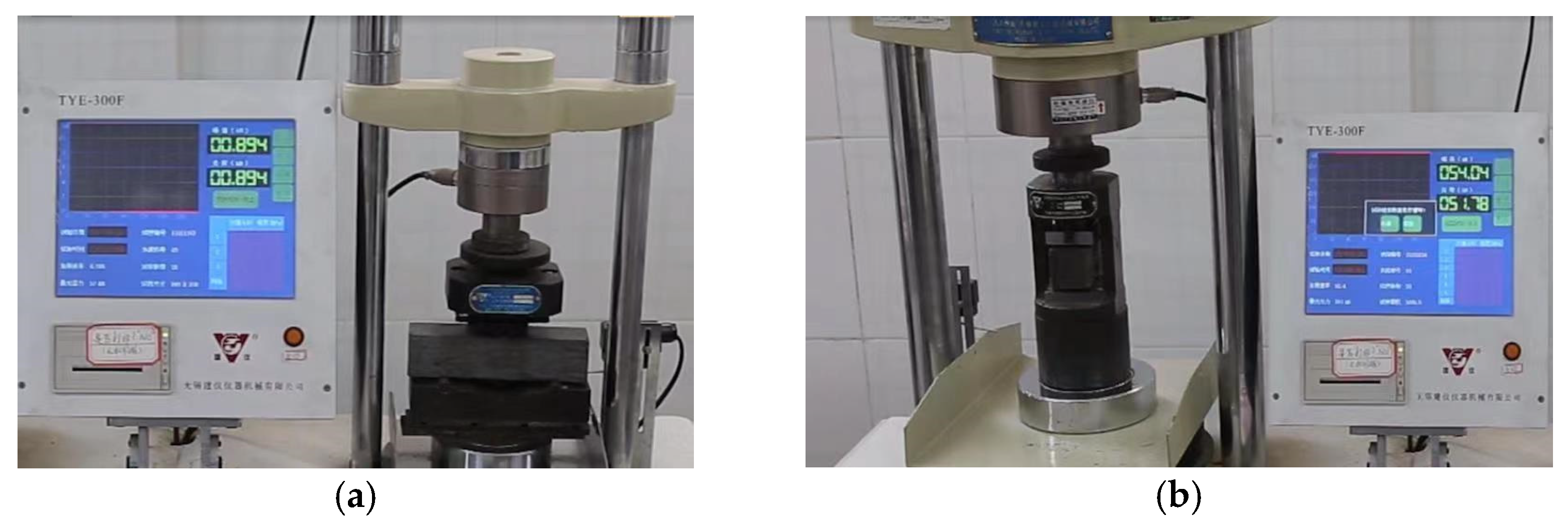
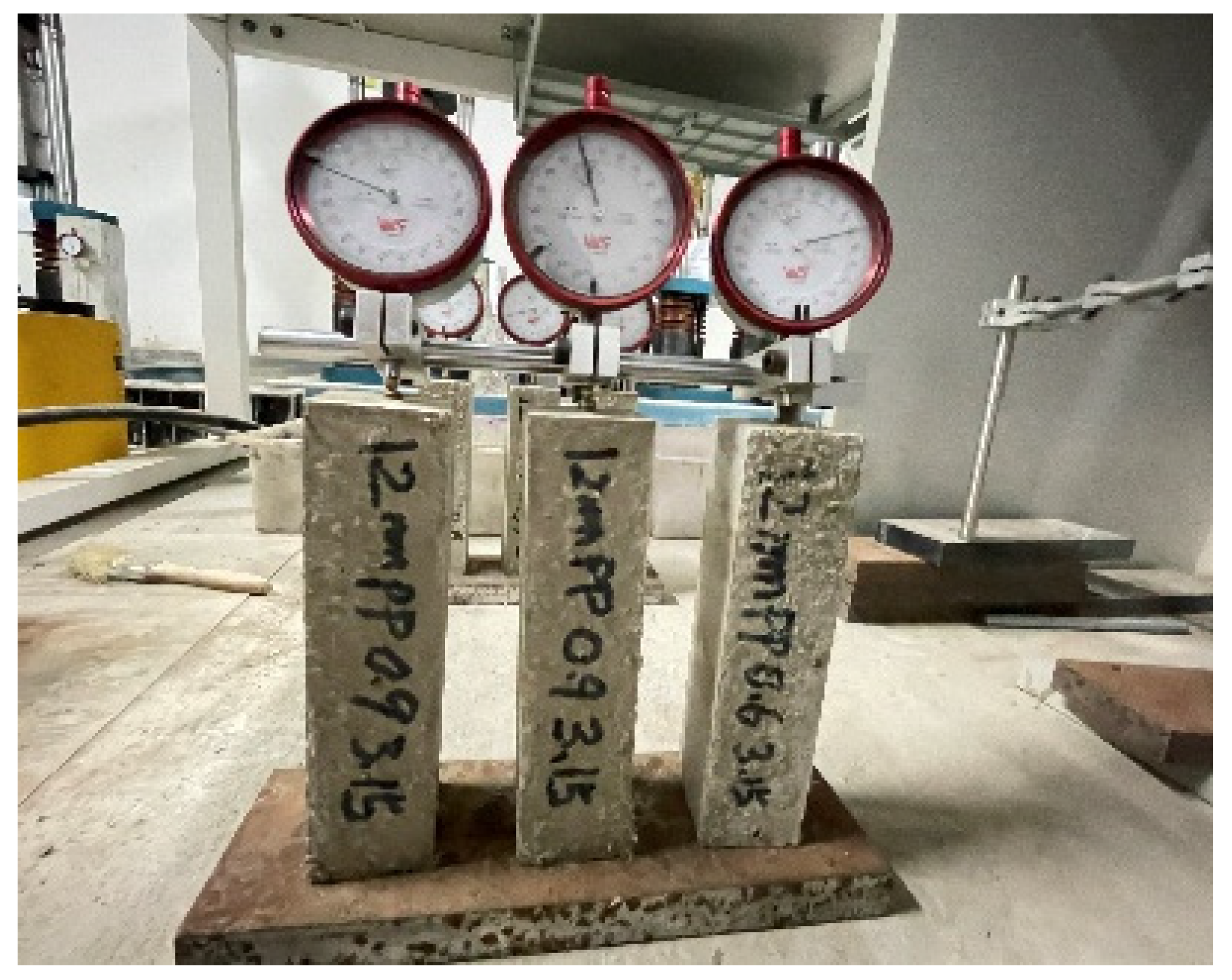
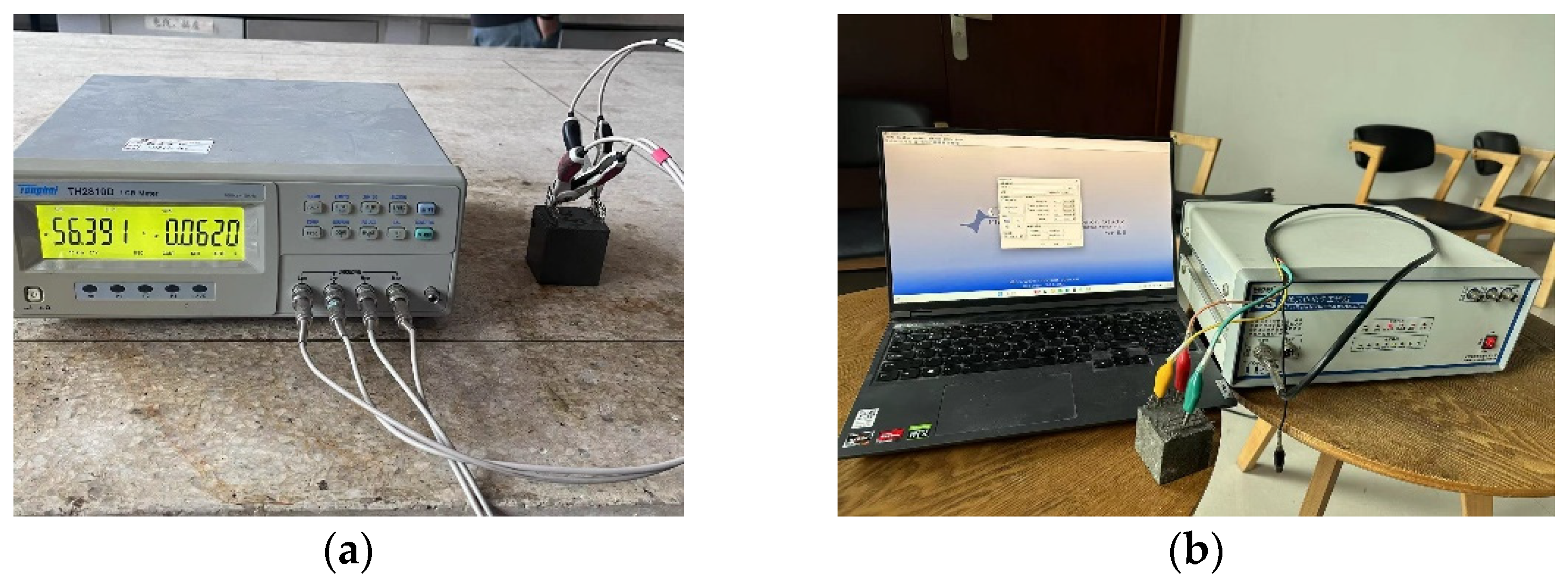
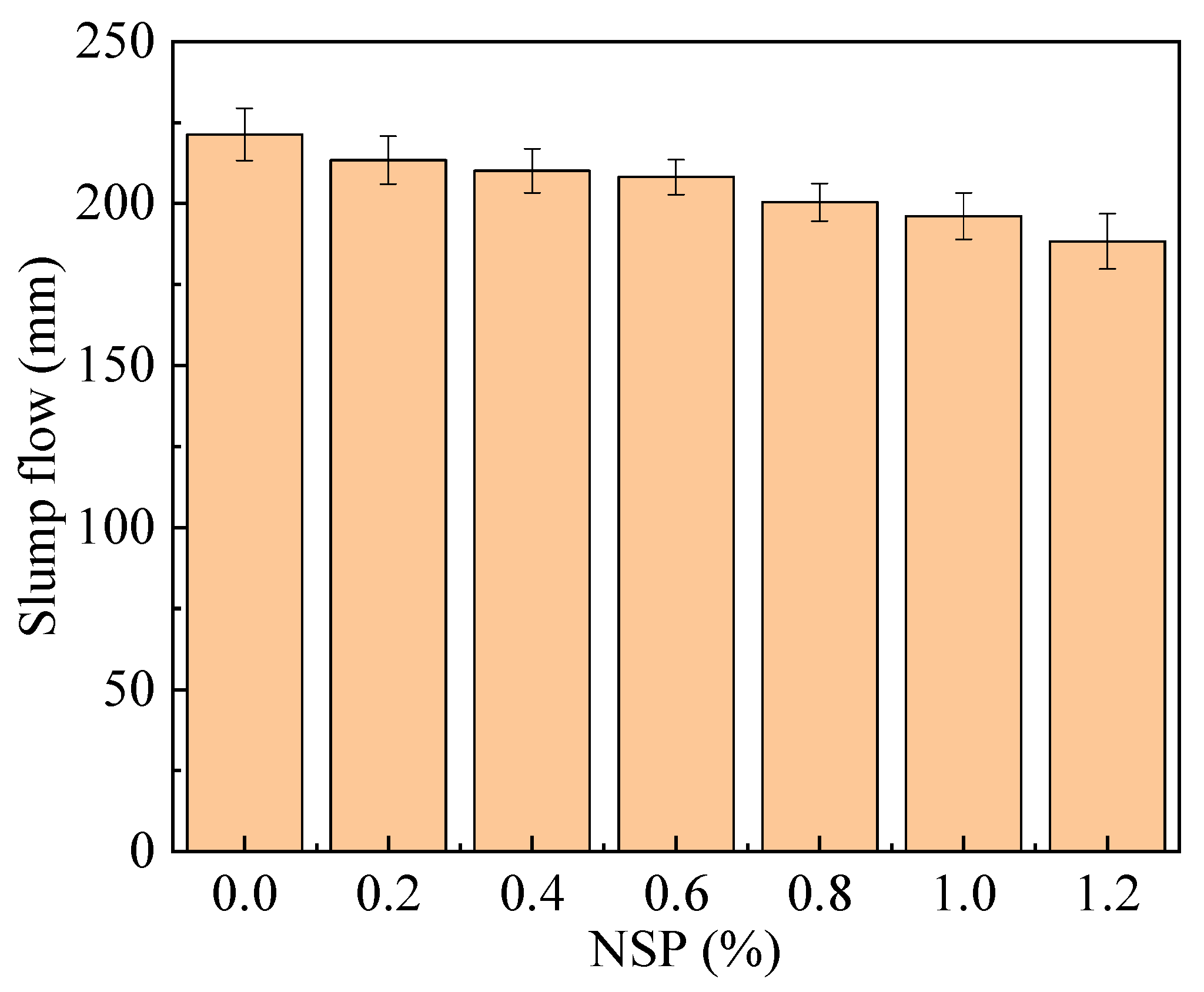
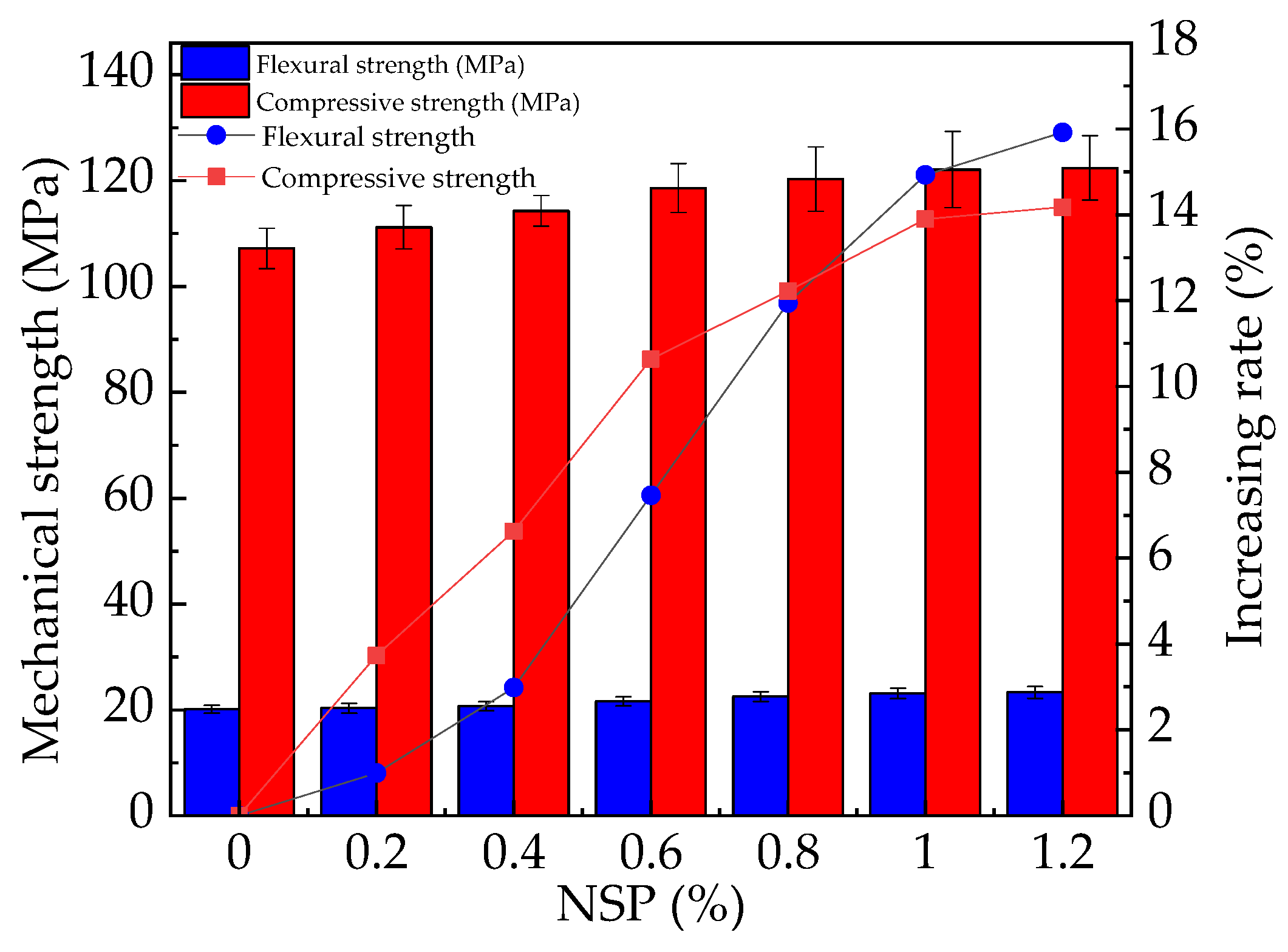
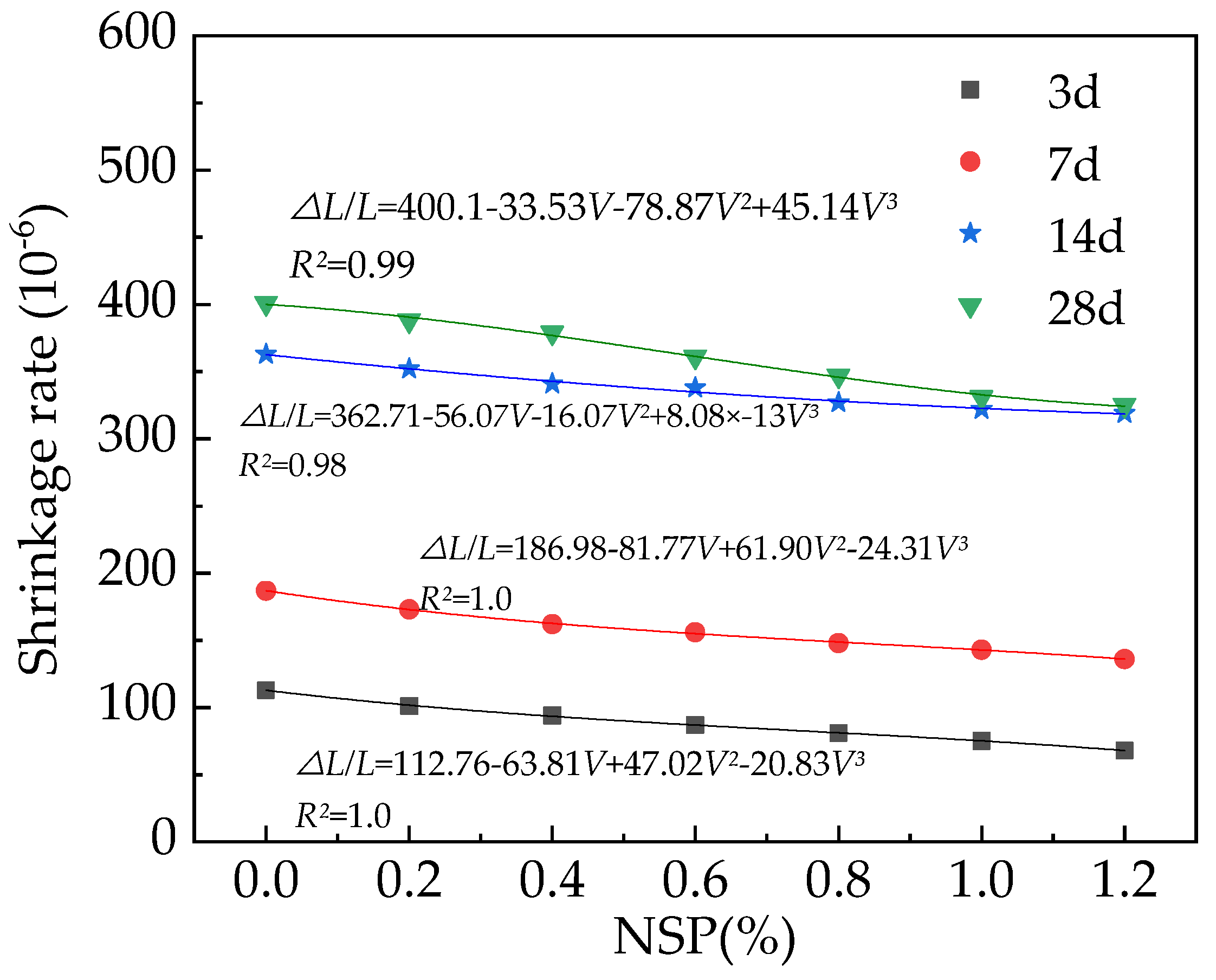
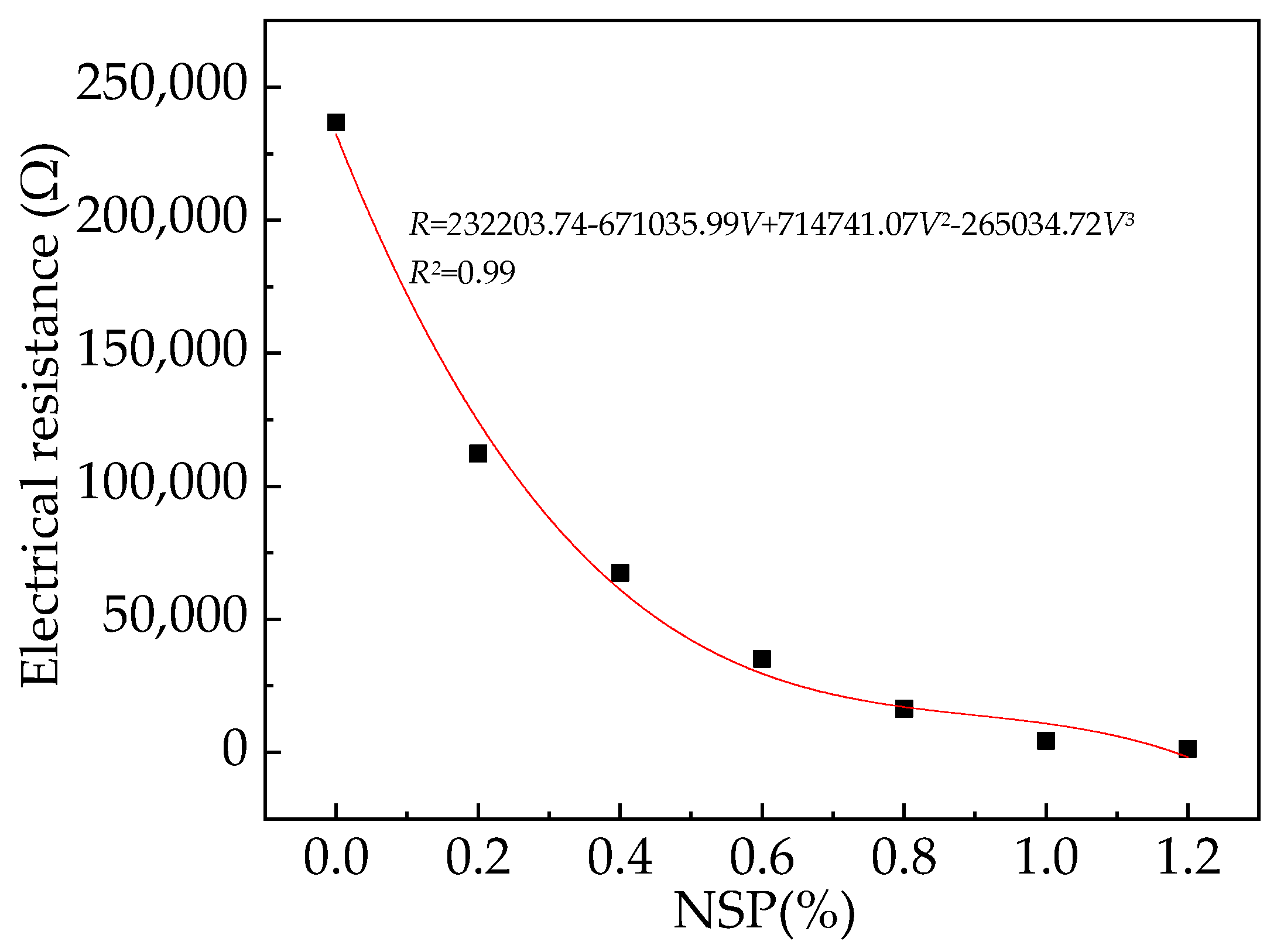
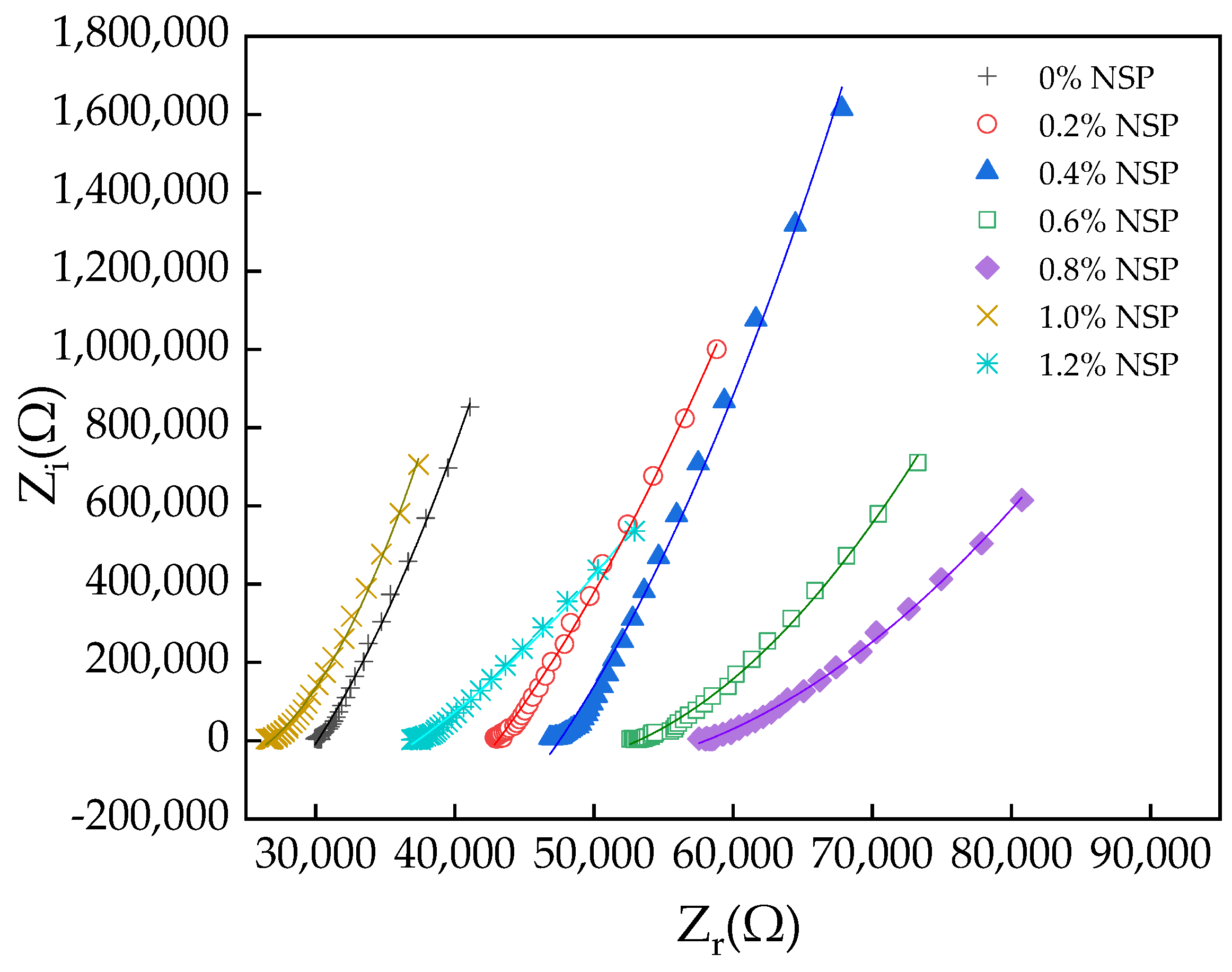

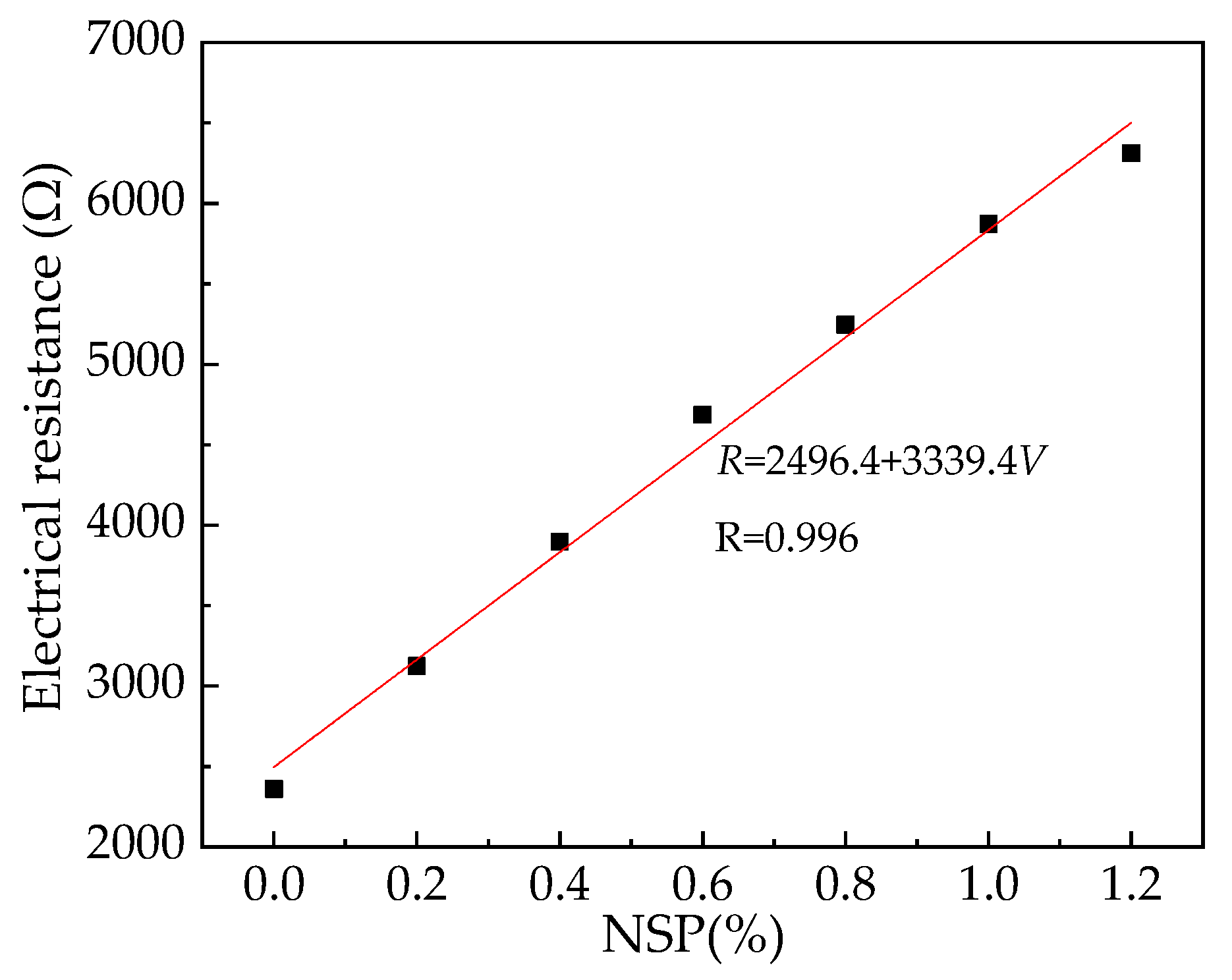

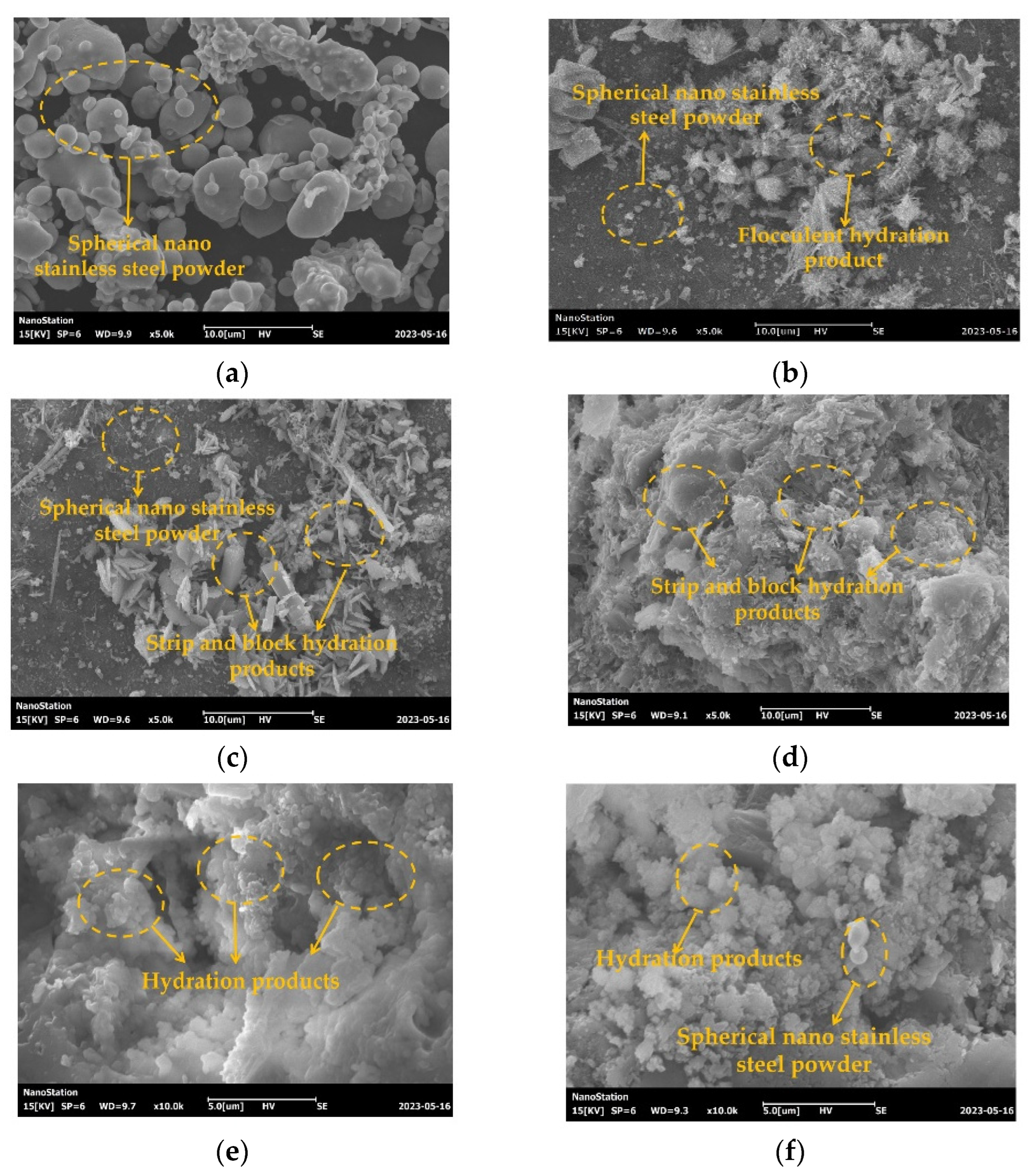
| Type Compositions | SiO2 | Al2O3 | FexOy | MgO | CaO | SO3 | K2O | Na2O | Ti2O | Fe | Ni | Loss on Ignition |
|---|---|---|---|---|---|---|---|---|---|---|---|---|
| OPC | 21.1 | 5.3 | 3.8 | 1.8 | 62.3 | 2.8 | - | - | - | - | - | 2.9 |
| BFS | 33.8 | 15.0 | 0.3 | 9.6 | 35.7 | 0.3 | 3.6 | - | - | - | - | - |
| Sand | 99.6 | - | 0.02 | - | - | - | - | - | - | - | - | - |
| SF | 97.6 | 0.2 | 0.2 | 0.2 | 0.4 | 0 | 1.4 | - | - | - | - | - |
| NSP | 0 | 0 | 0 | 0 | 0 | 0 | 0 | 0 | 0 | 99.95 | 0.05 | - |
| Particle Size (%) | 0.3 μm | 0.6 μm | 1 μm | 4 μm | 8 μm | 64 μm | 360 μm | |
|---|---|---|---|---|---|---|---|---|
| Types | ||||||||
| OPC | 0 | 0.5 | 3.1 | 14.5 | 33.2 | 92.1 | 100 | |
| BFS | 0.05 | 0.13 | 3.3 | 18.6 | 34.3 | 97.2 | 100 | |
| Sand | 0.02 | 0.03 | 0.04 | 0.05 | 0.06 | 19.8 | 100 | |
| SF | 35.2 | 59.1 | 83.6 | 95.7 | 99.3 | 99.5 | 100 | |
| NSP | 0 | 0.43 | 2.4 | 13.2 | 27.6 | 87.6 | 100 | |
| Water | OPC | SF | GGBS | Quartz Sand | NSP | Water-Reducer |
|---|---|---|---|---|---|---|
| 244.4 | 740.7 | 370.3 | 111.1 | 977.9 | 0 | 16.3 |
| 244.4 | 740.7 | 277.7 | 111.1 | 977.9 | 15.7 | 16.3 |
| 244.4 | 740.7 | 185.2 | 111.1 | 977.9 | 31.4 | 16.3 |
| 244.4 | 740.7 | 92.6 | 111.1 | 977.9 | 47.1 | 16.3 |
| 244.4 | 740.7 | 0 | 111.1 | 977.9 | 62.8 | 16.3 |
| 244.4 | 740.7 | 0 | 111.1 | 977.9 | 78.5 | 16.3 |
| 244.4 | 740.7 | 0 | 111.1 | 977.9 | 94.2 | 16.3 |
| Equation | Types | a | b | c | R2 |
|---|---|---|---|---|---|
| 1.0%NSP | 1,720,182.95 | −158.85 | 0.004 | 0.99 | |
| 0% NSP | 300,673.39 | −75.02 | 0.00216 | 0.99 | |
| 1.2% NSP | −31,174.88 | −23.26 | 6.47 × 10−4 | 0.99 | |
| 0.2% NSP | −25,499.32 | −46.09 | 0.001 | 0.99 | |
| 0.4% NSP | 829,947.91 | −87.27 | 0.001 | 0.99 | |
| 0.6% NSP | 1,937,829.91 | −89.17 | 9.92 × 10−4 | 0.99 | |
| 0.8% NSP | 1,150,300.24 | −53.71 | 5.84 × 10−4 | 0.99 |
| Equation | Types | a | b | R2 |
|---|---|---|---|---|
| 1.0%NSP | −0.0013 | 0.23 | 0.91 | |
| 0% NSP | −0.0000011 | −7.86 × 10−7 | 0.86 | |
| 1.2% NSP | −0.0014 | 0.20 | 0.88 | |
| 0.2% NSP | −0.028 | −0.11 | 0.93 | |
| 0.4% NSP | −0.042 | 2.15 | 0.94 | |
| 0.6% NSP | −0.075 | −6.98 | 0.92 | |
| 0.8% NSP | −0.043 | 1.22 | 0.89 |
Disclaimer/Publisher’s Note: The statements, opinions and data contained in all publications are solely those of the individual author(s) and contributor(s) and not of MDPI and/or the editor(s). MDPI and/or the editor(s) disclaim responsibility for any injury to people or property resulting from any ideas, methods, instructions or products referred to in the content. |
© 2023 by the authors. Licensee MDPI, Basel, Switzerland. This article is an open access article distributed under the terms and conditions of the Creative Commons Attribution (CC BY) license (https://creativecommons.org/licenses/by/4.0/).
Share and Cite
Xu, F.; Zhou, J.; Chang, R.; Zhang, D.; Wang, H.; Tian, X. The Mechanical and Self-Sensing Performance of Reactive Powder Cement Concrete with Nano-Stainless Steel Powder. Coatings 2023, 13, 1153. https://doi.org/10.3390/coatings13071153
Xu F, Zhou J, Chang R, Zhang D, Wang H, Tian X. The Mechanical and Self-Sensing Performance of Reactive Powder Cement Concrete with Nano-Stainless Steel Powder. Coatings. 2023; 13(7):1153. https://doi.org/10.3390/coatings13071153
Chicago/Turabian StyleXu, Feng, Jiwei Zhou, Rencai Chang, Dongling Zhang, Hui Wang, and Xiaoning Tian. 2023. "The Mechanical and Self-Sensing Performance of Reactive Powder Cement Concrete with Nano-Stainless Steel Powder" Coatings 13, no. 7: 1153. https://doi.org/10.3390/coatings13071153
APA StyleXu, F., Zhou, J., Chang, R., Zhang, D., Wang, H., & Tian, X. (2023). The Mechanical and Self-Sensing Performance of Reactive Powder Cement Concrete with Nano-Stainless Steel Powder. Coatings, 13(7), 1153. https://doi.org/10.3390/coatings13071153







